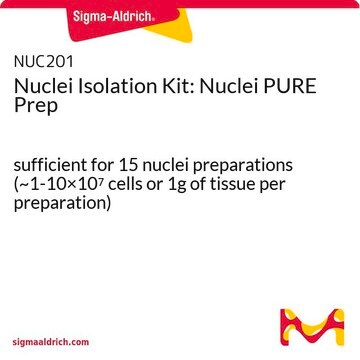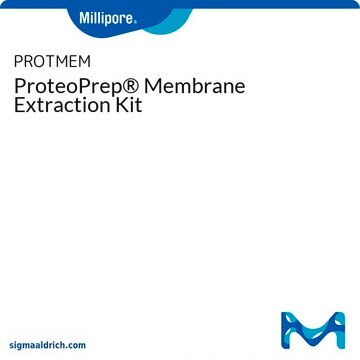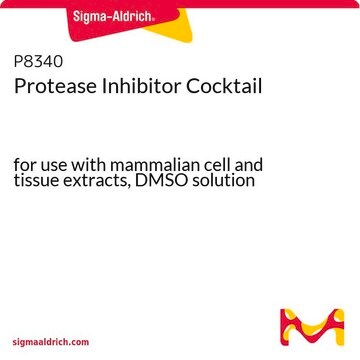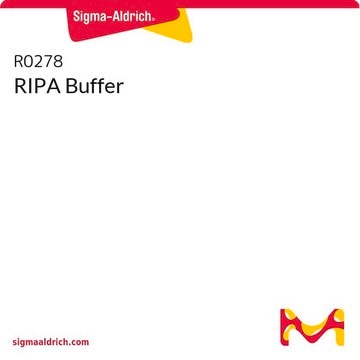2900
Nuclear Extraction Kit
Synonym(e):
Nuclear Isolation Kit
Anmeldenzur Ansicht organisationsspezifischer und vertraglich vereinbarter Preise
Alle Fotos(1)
About This Item
UNSPSC-Code:
41116012
eCl@ss:
32160405
Empfohlene Produkte
Hersteller/Markenname
Chemicon®
Methode(n)
protein extraction: suitable
Anwendung(en)
sample preparation
Versandbedingung
dry ice
Anwendung
CHEMICON′s Nuclear Extraction Kit (Catalog No. 2900) provides a simple and convenient method for the isolation of cytoplasmic and nuclear samples from mammalian cell culture or tissue samples. The Nuclear Extraction Kit can be used in the preparation of purified proteins for use in Western blotting, Electrophoretic Mobility Shift Assays (EMSA), and in CHEMICON′s Transcription Factor Assay product line.
For Research Use Only; Not for use in diagnostic procedures.
For Research Use Only; Not for use in diagnostic procedures.
Research Category
All
All
Komponenten
Cytoplasmic Lysis Buffer, 10x: - (Part No. 90497) One vial containing 10mL of a concentrated lysis buffer. Dilute to a 1x in deionized water.
Nuclear Extraction Buffer: - (Part No. 90498) One vial containing 50mL of a 1x nuclear extraction buffer.
PBS Packets: - (Part No. 60093) Two pouches containing enough dry reagent to prepare 1 liter of a 1x PBS solution per pouch. Dilute packet in deionized water.
DTT, 1M: - (Part No. 90499) One vial containing 100 μL of 1M Dithiothreitol. Prior to use, dilute to a final concentration of 0.5mM (1:2000) in 1x Cytoplasmic Lysis Buffer and 1x Nuclear Extraction Buffer.
Protease Inhibitor Cocktail: - (Part No. 90492) One vial containing 100μL of protease inhibitors in DMSO for use with mammalian cell and tissue extract buffers. A mixture of protease inhibitors with broad specificity for the inhibition of serine, cysteine and aspartic acid proteases and aminopeptidases. Contains 4-(2-aminoethyl)benzenesulfonyl fluoride (AEBSF), pepstatin A, E-64, bestatin, leupeptin, and aprotinin. Contains no metal chelators (e.g. EDTA, EGTA). Prior to use, dilute 1/1000 in 1x Cytoplasmic Lysis Buffer and 1x Nuclear Extraction Buffer.
Detergent, 10%: - (Part No. 90500) One vial containing 3mL of 10% IGEPAL CA-630 (detergent). Cytoplasmic Lysis Buffer and Nuclear Extraction Buffer already contain detergent, however, under certain conditions, more detergent may be required - refer to Extraction Procedure.
Nuclear Extraction Buffer: - (Part No. 90498) One vial containing 50mL of a 1x nuclear extraction buffer.
PBS Packets: - (Part No. 60093) Two pouches containing enough dry reagent to prepare 1 liter of a 1x PBS solution per pouch. Dilute packet in deionized water.
DTT, 1M: - (Part No. 90499) One vial containing 100 μL of 1M Dithiothreitol. Prior to use, dilute to a final concentration of 0.5mM (1:2000) in 1x Cytoplasmic Lysis Buffer and 1x Nuclear Extraction Buffer.
Protease Inhibitor Cocktail: - (Part No. 90492) One vial containing 100μL of protease inhibitors in DMSO for use with mammalian cell and tissue extract buffers. A mixture of protease inhibitors with broad specificity for the inhibition of serine, cysteine and aspartic acid proteases and aminopeptidases. Contains 4-(2-aminoethyl)benzenesulfonyl fluoride (AEBSF), pepstatin A, E-64, bestatin, leupeptin, and aprotinin. Contains no metal chelators (e.g. EDTA, EGTA). Prior to use, dilute 1/1000 in 1x Cytoplasmic Lysis Buffer and 1x Nuclear Extraction Buffer.
Detergent, 10%: - (Part No. 90500) One vial containing 3mL of 10% IGEPAL CA-630 (detergent). Cytoplasmic Lysis Buffer and Nuclear Extraction Buffer already contain detergent, however, under certain conditions, more detergent may be required - refer to Extraction Procedure.
Lagerung und Haltbarkeit
The Nuclear Extraction Kit is shipped and stored at -20ºC.
·Cytoplasmic Lysis Buffer (10x), Nuclear Extraction Buffer (1x), 10% Detergent, and the PBS Packets can be stored at 2-8ºC.
·DTT, 1M and Protease Inhibitor Cocktail must be stored at -20ºC. Avoid repeated freeze-thaw cycles.
·Cytoplasmic Lysis Buffer (10x), Nuclear Extraction Buffer (1x), 10% Detergent, and the PBS Packets can be stored at 2-8ºC.
·DTT, 1M and Protease Inhibitor Cocktail must be stored at -20ºC. Avoid repeated freeze-thaw cycles.
Rechtliche Hinweise
CHEMICON is a registered trademark of Merck KGaA, Darmstadt, Germany
Haftungsausschluss
Unless otherwise stated in our catalog or other company documentation accompanying the product(s), our products are intended for research use only and are not to be used for any other purpose, which includes but is not limited to, unauthorized commercial uses, in vitro diagnostic uses, ex vivo or in vivo therapeutic uses or any type of consumption or application to humans or animals.
Signalwort
Danger
H-Sätze
Gefahreneinstufungen
Aquatic Chronic 3 - Eye Dam. 1 - Skin Irrit. 2
Lagerklassenschlüssel
10-13 - German Storage Class 10 to 13
WGK
WGK 3
Analysenzertifikate (COA)
Suchen Sie nach Analysenzertifikate (COA), indem Sie die Lot-/Chargennummer des Produkts eingeben. Lot- und Chargennummern sind auf dem Produktetikett hinter den Wörtern ‘Lot’ oder ‘Batch’ (Lot oder Charge) zu finden.
Besitzen Sie dieses Produkt bereits?
In der Dokumentenbibliothek finden Sie die Dokumentation zu den Produkten, die Sie kürzlich erworben haben.
Kunden haben sich ebenfalls angesehen
Hong Ma et al.
PloS one, 8(8), e71302-e71302 (2013-08-27)
Diminished Ikaros function has been implicated in the pathogenesis of acute lymphoblastic leukemia (ALL), the most common form of childhood cancer. Therefore, a stringent regulation of Ikaros is of paramount importance for normal lymphocyte ontogeny. Here we provide genetic and
Hayeong Kwon et al.
Journal of cellular and molecular medicine, 13(8A), 1549-1564 (2009-09-26)
Mitogenic regulation by caveolin-2 in response to insulin was investigated. Insulin triggered phosphorylation of caveolin-2 on tyrosine 19. Insulin increased the interaction between pY19-caveolin-2 and phospho-ERK, and that interaction was inhibited by a MEK inhibitor U0126. Insulin-induced interaction of caveolin-2
Valerie Bríd O'Leary et al.
Scientific reports, 7(1), 1790-1790 (2017-05-13)
PARTICLE (Gene PARTICL- 'Promoter of MAT2A-Antisense RadiaTion Induced Circulating LncRNA) expression is transiently elevated following low dose irradiation typically encountered in the workplace and from natural sources. This long non-coding RNA recruits epigenetic silencers for cis-acting repression of its neighbouring
Linli Yao et al.
PloS one, 8(11), e78439-e78439 (2013-11-14)
Neuroinflammation mediated by the activated microglia is suggested to play a pivotal role in the pathogenesis of hypoxic brain injury; however, the underlying mechanism of microglia activation remains unclear. Here, we show that the canonical Notch signaling orchestrates microglia activation
Xue Zhong et al.
Scientific reports, 6, 20654-20654 (2016-02-06)
Nuclear factor κB (NF-κB) plays an essential role in regulation of innate immunity. In mammals, NF-κB factors can form homodimers and heterodimers to activate gene expression. In insects, three NF-κB factors, Dorsal, Dif and Relish, have been identified to activate
Unser Team von Wissenschaftlern verfügt über Erfahrung in allen Forschungsbereichen einschließlich Life Science, Materialwissenschaften, chemischer Synthese, Chromatographie, Analytik und vielen mehr..
Setzen Sie sich mit dem technischen Dienst in Verbindung.


















